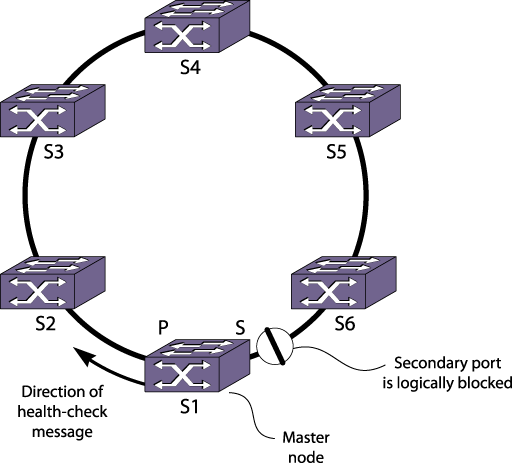The simplest EAPS (Extreme Automatic Protection Switching) configuration operates on a single ring.
This section describes how this type of EAPS configuration operates. Later sections describe more complex configurations.
An EAPS domain consists of one master node and one or more transit nodes (see EAPS Operation), and includes one control VLAN (Virtual LAN) and one or more protected VLANs.
A domain is a single instance of the EAPS protocol that defines the scope of protocol operation. A single logical EAPS domain typically exists on a given physical ring topology (fiber or copper).

A protected VLAN is a user data VLAN that uses the ring for a protected connection between all edge ports. The protected VLAN uses 802.1q trunking on the ring ports and supports tagged and untagged edge ports.
One ring port of the master node is designated the master node‘s primary port (P), and another port is designated as the master node‘s secondary port (S) to the ring. In normal operation, the master node blocks the secondary port for all protected VLAN traffic, thereby preventing a loop in the ring. (The spanning tree protocol, STP (Spanning Tree Protocol), provides the same type of protection.) Traditional Ethernet bridge learning and forwarding database mechanisms direct user data around the ring within the protected VLANs.

Note
Although primary and secondary ports are configured on transit nodes, both port types operate identically as long as the transit node remains a transit node. If the transit node is reconfigured as a master node, the configured states of the primary and secondary ports apply.When the master node detects a failure, due to an absence of health-check messages or a received link-down alert, it transitions the EAPS domain to the Failed state and unblocks its secondary port to allow data connectivity in the protected VLANs.

 Print
this page
Print
this page Email this topic
Email this topic Feedback
Feedback